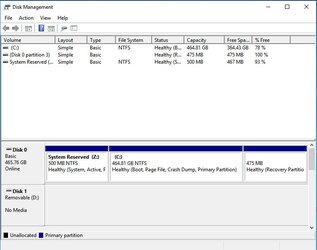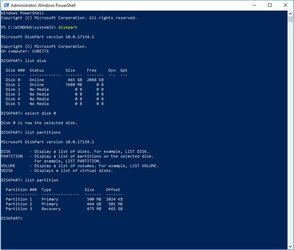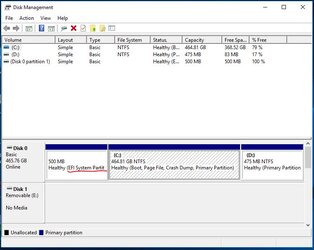- Joined
- Dec 27, 2008
Recently, I replaced my 256 gb SATA SSD with a 500 gb m.2 NVME.
Before changing the hardware I imaged the SATA SSD with Macrium Reflect.
After installing the smaller NVME drive I restored the system from the Macrium Reflect created image, which worked fine except it gave me a system partition about half the size of what the new, larger disk capacity would allow for.
Since the Restore partition came after the system partition I could not expand the system partition (C to use the unallocated space at the end. So, using diskpart I deleted the Recovery partition and then expanded the system partition to include the unallocated space. Since I image the hard drive on a scheduled basis using an external backup drive attached to my router, not having a recovery partition is not a big deal to me.
to use the unallocated space at the end. So, using diskpart I deleted the Recovery partition and then expanded the system partition to include the unallocated space. Since I image the hard drive on a scheduled basis using an external backup drive attached to my router, not having a recovery partition is not a big deal to me.
After deleting the recovery partition the system ran normally but I ran into a problem with not being able to run the Windows Defender boot time scan. So I did an in place rebuild of the system from a Windows 10 image which fixed the boot time scan problem. In addition, it rebuilt the recovery partition, seen now at the right end in Disk Manager.
Looking at the partitions this morning in Disk Manager I noticed there is no EFI partition. Not sure it was there before the in place system rebuild from ISO or not. How could this be? Yes, the motherboard is a modern one with UEFI technology. Is this just a labeling issue? Is (Z the EFI partition but not labeled as such? Can the EFI partition be "Simple"?
the EFI partition but not labeled as such? Can the EFI partition be "Simple"?
Before changing the hardware I imaged the SATA SSD with Macrium Reflect.
After installing the smaller NVME drive I restored the system from the Macrium Reflect created image, which worked fine except it gave me a system partition about half the size of what the new, larger disk capacity would allow for.
Since the Restore partition came after the system partition I could not expand the system partition (C
After deleting the recovery partition the system ran normally but I ran into a problem with not being able to run the Windows Defender boot time scan. So I did an in place rebuild of the system from a Windows 10 image which fixed the boot time scan problem. In addition, it rebuilt the recovery partition, seen now at the right end in Disk Manager.
Looking at the partitions this morning in Disk Manager I noticed there is no EFI partition. Not sure it was there before the in place system rebuild from ISO or not. How could this be? Yes, the motherboard is a modern one with UEFI technology. Is this just a labeling issue? Is (Z
Attachments
Last edited:



